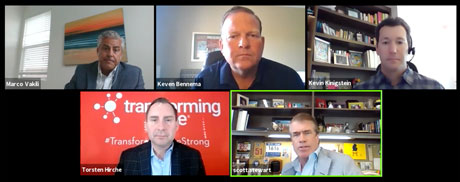The seniors housing industry has had a rough ride through the COVID-19 pandemic. First-quarter occupancy clocked in at a record-low 78.8 percent, a drop of 870 basis points from the year prior, according to NIC MAP Data, Powered by NIC MAP Vision.
But seniors housing is a needs-based product, and most industry professionals expect a strong rebound. As a result, new construction projects are starting to make a comeback in preparation for pent-up demand.
That was the topic of discussion during “The Power Panel: CEOs Discuss the State of Development” at France Media’s InterFace Seniors Housing Development, Design & Finance conference, held virtually on April 20 and 21.
Panelists included Marco Vakili of Alliance Residential; Keven Bennema of Charter Senior Living; moderator Kevin Kinigstein of Cox, Castle & Nicholson; Scott Stewart of Capitol Seniors Housing; and Torsten Hirche of Transforming Age.
“The pandemic was a double whammy. Revenue is going down and expenses are going up,” said Stewart. “The good news is it wasn’t as bad as we thought. Fast forward to where we are today, we’re essentially at the same occupancy level as we were in March of 2020. That gave us the green light for developing.”
Capitol Seniors Housing currently has five projects underway, Stewart noted.
Although all the panelists are working on expansions or new development, the process for approval has become noticeably more arduous, they reported.
“There is a different level of scrutiny and focus from capital providers with what information they need to provide to have everyone feel good about a deal,” explained Kinigstein.
“You need a strong track record, development partner and contractor,” added Bennema. “If we’re not bringing a team to the table that can check all the boxes, it’s going to be very hard to get anything done. If you’re not honest with your lenders, they’re pushing back. There are a lot of deals falling apart that looked great on paper.”
Although new development is underway, the panelists have become much more careful about unit mix and market selection.
“We’re more bullish on the assisted living and memory care component. We think independent living is going to lag a bit coming back because of the needs-based part of the decision,” said Vakili, referring to prospective residents.
Alliance Residential prefers to develop 85- to 120-unit properties in submarkets where seniors have lived for 20 to 30 years and don’t want to leave their neighborhood.
For its part, Transforming Age has two major projects under construction — a high-rise in Seattle and a development in Nebraska. However, the company’s main focus is not on ground-up development.
“There’s a lot of pent-up demand for new product, but we’re not pursuing standalone assisted living and memory care,” said Hirche. “We’re focusing on campus expansions, active adult and affordable housing. Affordability was already an issue, and that’s been exacerbated by this crisis.”
To view an on-demand version of the full panel, register for the conference by clicking here.
— Jeff Shaw

